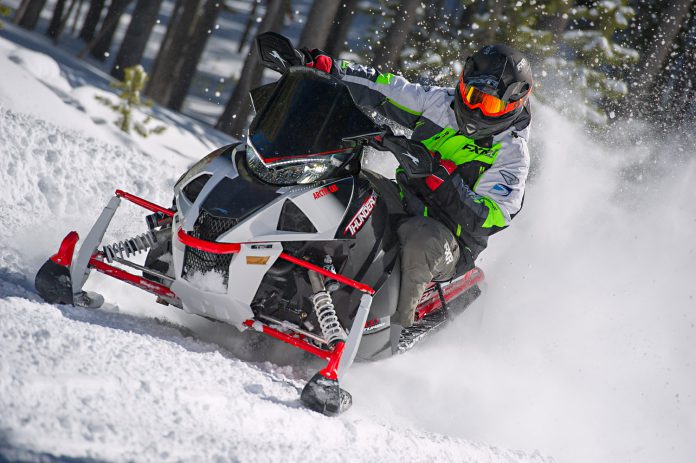Supertrax:
Prior to the 2017s being introduced we had access to a Viper with a 1049 triple and an aftermarket turbo installed. How would you rate that experience? What did you learn?
Luke Lester:
I think the most interesting bit of info we gathered from our time with the 1049 turbo was that the motor could easily handle the power. There were no concerns about engine durability. On top of that, we got just a taste of what this motor, when pushed harder, was capable of… and it was impressive to say the least.
Supertrax:
What’s your opinion of turbocharged snowmobiles in general?
Luke:
I love the power. There really is nothing that can equal the feeling of a boosted snowmobile putting huge horsepower to the ground. I also feel they need to be as invisible as possible. We learned all about turbo lag when the first crop of turbo sleds became available, and determined turbo lag is a big issue on a sled.
Today, manufactures have found ways to drastically reduce, if not nearly eliminate lag, making it more difficult to tell weather your riding a sled with a turbo, or just one that makes insane power.
Supertrax:
What was your reaction when you first heard the 2017 Cat Turbo would be using a 998cc 3-cylinder Yamaha engine instead of the former 1056cc Suzuki twin or even the 1049? Was dropping 50 cubes a good or a bad thing?
Luke:
I can’t describe how happy I was to hear they were dropping the Suzuki twin in favour of the Yamaha triple. Its quickly becoming clear that a triple delivers the kind of power snowmobilers both want and need. The torque of a twin with the top end of an inline 4. It’s not at all a surprise to see Arctic start with the 998 though. It’s a logical move when you consider the implications of cross platform development of that engine in snowmobiles in the winter and off road vehicles in the summer.
Supertrax:
What have you found to be the most impressive feature of the new 9000 series Cats?
Luke:
Historically, high horsepower turbos have been heavy. The Suzuki turbo certainly fit this description. So the new 9000 being lighter with the mass more centralized is a big improvement. Second, the new design of the bodywork is just fantastic. This is the best fit and finish we’ve ever seen from Arctic Cat. Its functional, its easy to remove and the fastening system is flawless… and it looks fantastic.
Supertrax:
How does the handling compare with, say, a Cat 8000 2-stroke?
Luke:
Thanks to better mass placement and overall lighter weight the new 9000s handling is far closer to that of the 8000 series 2 strokes than ever before. Yes, you can still feel the weight, but it doesn’t have the same negative effect on the vehicle in the corners.
In fact, in some circumstances, that extra bit of weight helps keep the skis on the ground and provides better bite in the corners. I would say it’s not quite AS flickable as the 8000, but overall handling is really good.
Supertrax:
What do you feel is the 9000’s best application: Trail, crossover, freestyle, mountain?
Luke:
First, and most obviously, is on the trail. Because it handles so well, yet produces so much horsepower with so little turbo lag, it’s a real pleasure to ride all day. There’s no tradeoff to get the horsepower. But that horsepower is definitely there when you want to unleash it on some unsuspecting victim.
Next is in the mountains. There will never be a replacement for a high horsepower, lightweight 2 stroke engine, but the lighter you can make a turbocharged 4 stroke, the better it will get in the steep and deep. hen you consider that the turbo is going to maintain most of its horsepower from sea level all they way up to 10 000 plus feet… the higher you go, the better that sled starts to look and feel.
Supertrax:
Is 180-hp too much or is there still room for more in the marketplace?
Luke:
10 years ago people would have said 180hp is way more than any person could need or handle, bBut we know different now. I think there will always be room for more horsepower in the snowmobile industry. There will certainly always be people to buy these increasingly powerful hyper sleds. The question isn’t “how much power is too much?” The question is “how much power is possible. “




